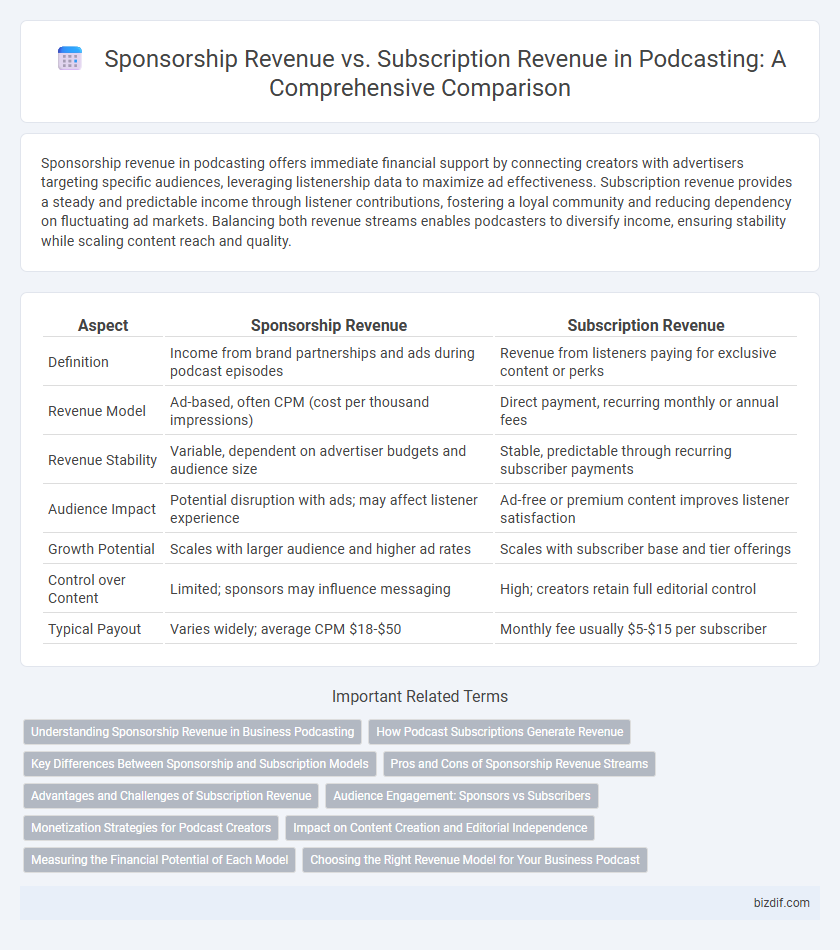Sponsorship revenue in podcasting offers immediate financial support by connecting creators with advertisers targeting specific audiences, leveraging listenership data to maximize ad effectiveness. Subscription revenue provides a steady and predictable income through listener contributions, fostering a loyal community and reducing dependency on fluctuating ad markets. Balancing both revenue streams enables podcasters to diversify income, ensuring stability while scaling content reach and quality.
Table of Comparison
| Aspect | Sponsorship Revenue | Subscription Revenue |
|---|---|---|
| Definition | Income from brand partnerships and ads during podcast episodes | Revenue from listeners paying for exclusive content or perks |
| Revenue Model | Ad-based, often CPM (cost per thousand impressions) | Direct payment, recurring monthly or annual fees |
| Revenue Stability | Variable, dependent on advertiser budgets and audience size | Stable, predictable through recurring subscriber payments |
| Audience Impact | Potential disruption with ads; may affect listener experience | Ad-free or premium content improves listener satisfaction |
| Growth Potential | Scales with larger audience and higher ad rates | Scales with subscriber base and tier offerings |
| Control over Content | Limited; sponsors may influence messaging | High; creators retain full editorial control |
| Typical Payout | Varies widely; average CPM $18-$50 | Monthly fee usually $5-$15 per subscriber |
Understanding Sponsorship Revenue in Business Podcasting
Sponsorship revenue in business podcasting involves monetizing through partnerships with brands that align with the podcast's audience and content, often providing tailored advertising messages during episodes. This form of revenue leverages listener engagement and targeted demographics to deliver high ROI for sponsors, making it a crucial income stream for monetizing niche business podcasts. Unlike subscription revenue, which depends on a direct listener payment model, sponsorship revenue can scale significantly with audience size and influence.
How Podcast Subscriptions Generate Revenue
Podcast subscriptions generate revenue by offering exclusive content, ad-free episodes, and early access to paying listeners, creating a steady income stream beyond traditional advertising. Subscription platforms like Apple Podcasts and Patreon enable podcasters to monetize their loyal audience directly, ensuring predictable monthly earnings. This model enhances creator autonomy and financial stability compared to variable sponsorship revenue tied to fluctuating ad market demand.
Key Differences Between Sponsorship and Subscription Models
Sponsorship revenue in podcasting relies on advertisers paying to promote their products during episodes, generating income based on audience size and engagement metrics. Subscription revenue comes from listeners who pay recurring fees for exclusive content or ad-free experiences, providing a more predictable and stable income stream. Key differences include the dependency on external advertisers for sponsorships versus direct listener support in subscriptions, impacting control over content and revenue consistency.
Pros and Cons of Sponsorship Revenue Streams
Sponsorship revenue in podcasting offers immediate financial support through brand partnerships, often scaling with audience size and engagement metrics, making it attractive for podcasters with sizable, niche audiences. However, reliance on sponsorships can lead to inconsistent income streams, dependency on external brands, and potential listener alienation if ads disrupt content flow or clash with audience values. Despite these challenges, sponsorship revenue remains a key monetization avenue for podcasters leveraging targeted advertising to maintain free access for listeners while building profitable collaborations.
Advantages and Challenges of Subscription Revenue
Subscription revenue in podcasting offers predictable income streams by directly engaging loyal listeners who value exclusive content or ad-free experiences. This model enhances audience retention and fosters a community, but it requires consistent high-quality production and effective marketing to justify ongoing payments. Challenges include subscriber acquisition costs, content piracy risks, and balancing free versus premium offerings to avoid alienating casual listeners.
Audience Engagement: Sponsors vs Subscribers
Sponsorship revenue in podcasting hinges on large-scale audience engagement where advertisers value reach and demographic targeting to maximize brand exposure. Subscriber revenue depends on cultivating a loyal, niche audience willing to pay for exclusive content, fostering deeper listener commitment. Sponsors prioritize quantity and impression metrics, while subscription models emphasize quality and sustained listener interaction.
Monetization Strategies for Podcast Creators
Sponsorship revenue dominates as the primary monetization strategy for podcast creators, leveraging brand partnerships to generate consistent income through targeted ads. Subscription revenue is emerging as a complementary model, offering exclusive content and ad-free experiences to dedicated listeners willing to pay monthly fees. Balancing sponsorship deals with subscription offerings allows creators to diversify income streams and maximize overall revenue potential.
Impact on Content Creation and Editorial Independence
Sponsorship revenue provides podcasters with substantial funding that can influence content creation by encouraging alignment with brand values and advertiser preferences, potentially limiting editorial independence. Subscription revenue offers a more predictable income stream driven directly by listener loyalty, allowing creators greater freedom to produce diverse and niche content without advertiser constraints. Balancing these revenue models is crucial for sustaining creative integrity while ensuring financial viability in the podcasting industry.
Measuring the Financial Potential of Each Model
Sponsorship revenue in podcasting often relies on CPM (cost per mille) rates, with top shows earning $25-$50 CPM, making it a scalable model tied to audience size and engagement metrics. Subscription revenue, driven by platforms like Patreon or Spotify, offers predictable monthly income per subscriber, typically between $5-$15, providing more financial stability and direct listener support. Measuring the financial potential of each model involves analyzing audience demographics, engagement rates, and monetization conversion metrics to determine which approach maximizes revenue growth and sustainability.
Choosing the Right Revenue Model for Your Business Podcast
Choosing the right revenue model for your business podcast involves evaluating Sponsorship Revenue, which offers immediate cash flow through brand partnerships and targeted ads, against Subscription Revenue that generates consistent income from loyal listeners through paid access or exclusive content. Sponsorship Revenue typically scales quickly and attracts advertisers interested in specific demographics, while Subscription Revenue fosters long-term relationships and predictable earnings, essential for content sustainability. Balancing both models can maximize profitability by leveraging sponsorship strengths and subscription stability tailored to your audience size and engagement level.
Sponsorship Revenue vs Subscription Revenue Infographic

 bizdif.com
bizdif.com